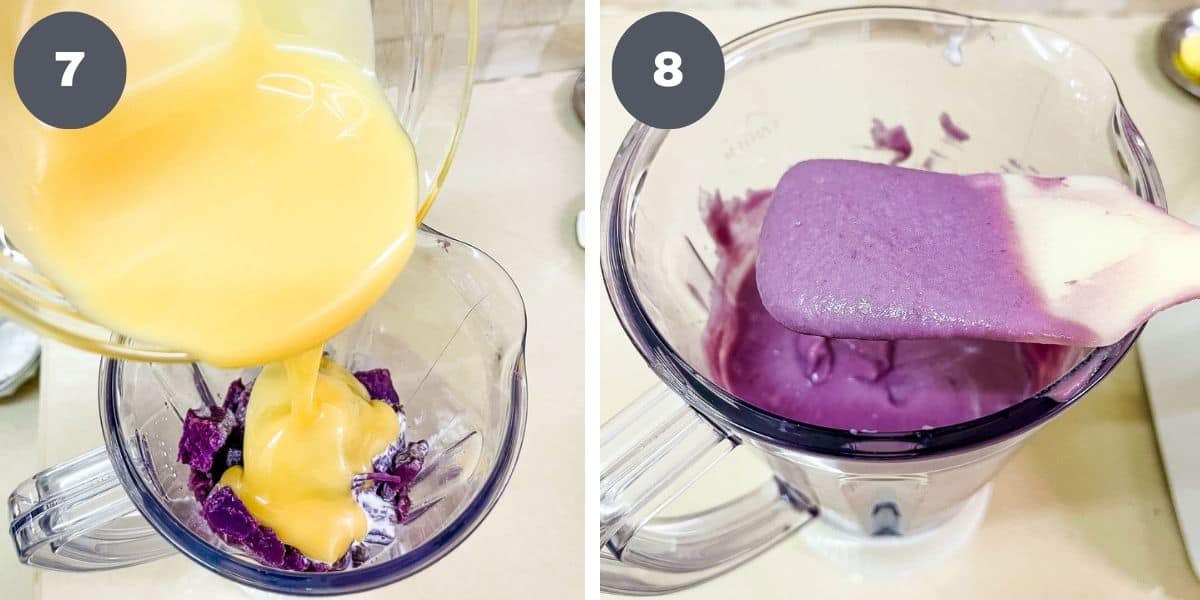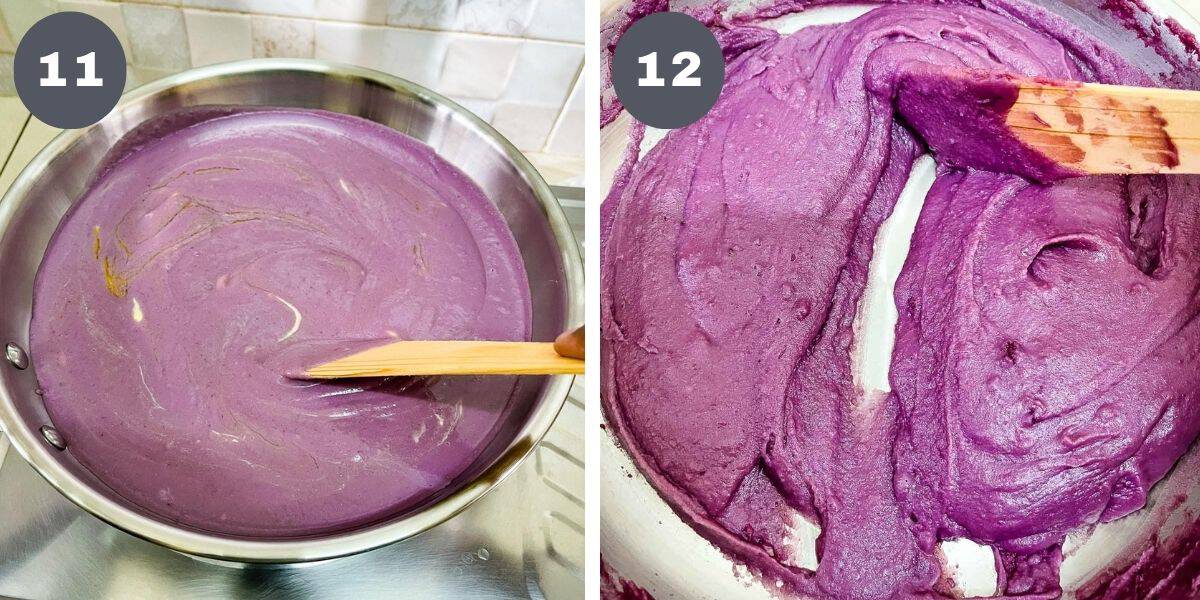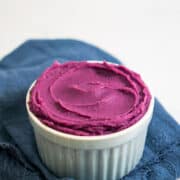This homemade ube halaya (ube jam) recipe makes deliciously smooth and creamy, naturally colored dessert that is not just great to be enjoyed on its own as a sweet treat (with latik and cheese topping), but also makes a great ingredient for a whole lot of ube treats like ube ice cream, ube brownies, ube mochi, ube rolls, ube latte and ube milk tea.

Also known as halayang ube, or Filipino jam, ube halaya is a traditional Filipino dessert made using ube (purple yam). Ube is a purple yam and is native to the Philippines. It is widely used in many Filipino cuisine especially Filipino desserts like ube leche flan cake, halo halo, ube pandesal and others.
Ube halaya is typically cooked and molded in an oval shaped tin called Llanera and topped with Latik (toasted coconut milk curd) and cheese and served as a pudding.
Purple being my favorite color, ube first came to my attention because of its color. I loved the fact that yam could produce such a lovely natural color without any additional artificial food coloring.
Similar to this homemade pumpkin puree recipe, this ube recipe is made without any artificial coloring and is very easy to make.
Jump to:
Purple Yam vs Purple Sweet Potato vs Taro
- Purple yam (ube) and purple sweet potatoes (like the Okinawan sweet potatoes) have almost identical shapes, outer skin texture (some are dark brown and some lighter brown) and flesh color (both come in vivid purple flesh). In terms of taste, both have a similar sweet, slightly earthy and nutty flavor with subtle differences.
- Taro has a completely different outer skin (dark brown) and has an almost white interior with very light purple spots. It is easily distinguishable from purple yam.
❤️Why you will love this recipe
- This is an easy recipe.
- It is packed with delicious ube flavor and has a beautiful deep purple color, all naturally derived from ube.
- You get to adjust the level of sweetness of the ube halaya, unlike store bought ones which are often very sweet. This recipe makes not-so-sweet jam. You can even adjust the sweetness level further if you so wish.
- You can enjoy this dish on its own, or as a spread for your toast, or use it as an ingredient to flavor your other sweet treats like ice cream, cakes, cupcakes and beverages.
📋Ingredients

- Ube (purple yam) - this is the key ingredient. This recipe requires fresh, uncooked purple yam. You can also use frozen grated yam, however, the cooking method will differ slightly. See 'How to Make' section below.
- Condensed milk and evaporated milk - sweetens and contributes to the creaminess of the jam.
- Full fat coconut milk - contributes to the rich and delicious coconut flavor of the ube halaya.
- Sugar - adds to the sweet taste of the ube halaya. White sugar is recommended to preserve the purple color of the ube. Both coarse or granulated sugar will work.
- Butter - I use salted butter, but unsalted butter will also work fine for this recipe.
- Salt - just a small pinch to enhance the taste.
*Refer to the recipe card below for full list of ingredients and exact quantities. For best results, use a digital kitchen scale where applicable*
🧾Substitution and variations
- This recipe uses fresh ube. If fresh ube is not readily available, you can substitute it with frozen grated ube (cooked). See the "how to make" section below on how to use grated ube.
- If you are not able to find ube at all, you can also make this recipe with purple sweet potatoes.
- For a brighter purple color, you can add half a teaspoon of ube extract when cooking the jam.
- You can also add one teaspoon of vanilla extract for a vanilla flavored ube halaya.
This recipe has not been tested with other substitutions or variations. If you do try, please let me know in the comments section below!
👩🏻🍳How to make
Step 1: Cook the ube. Since ube is grown underground, it is often covered in dirt (soil). Washing it thoroughly helps remove the dirt but I prefer to remove the skin completely before cooking it just to be sure.

Rinse the ube to remove any dirt (image 1). Chop into large pieces and peel the skin by cutting it off using a sharp knife (image 2).

Once the skin the peeled, chop each piece into smaller pieces (image 3). This helps them cook faster.
Rinse the chopped ube in water. Place them in a medium-sized pot and fill the pot with water such that the ube is all submerged below the water level (image 4).

Boil the ube pieces over medium-low heat until they become soft. To test, lift out a piece of ube onto a plate and use a fork to break it (image 5). If it breaks easily, the ube is cooked. Depending on the size of the ube pieces, this would take between 15 to 20 minutes .
Note: You can also steam the ube instead of boiling it in water.
Drain out all the water. You can do this by pouring out the ube along with the water into a colander and let the water drain off completely (image 6).

Step 2: Process the ube until smooth. Place the drained ube chunks into a blender or food processor. Add the sweetened condensed milk, followed by coconut milk and evaporated milk (image 7).
Blend the ube until smooth (image 8).
Note: You may need to constantly use a long spoon or stirrer to stir the ube in the blender for it to operate smoothly. Alternatively, use an immersion blender (hand blender or food processor).

Step 3: Cook the ube. Pour the smoothly blended ube paste into a saucepan (image 9). Turn on the stove to a low flame.
Add the butter and the salt (image 10).

Cook the ube jam over low heat for about 45 minutes. Stir the jam constantly, scraping the bottom and sides of the pan continuously to avoid the jam from sticking to the bottom of the pot or pan (image 11). Also, towards the end of the cooking process, as the jam starts to thicken, it will start spitting. Keep the lid on when you are not stirring.
The jam will thicken further (to a spreadable consistency) as it cools down so you need not cook it until it is completely thickened. You can test by using your spoon to scrape the jam across the pan. If it stays in place, the jam is done (image 12). Remove it from heat.
Note: If using frozen grated ube, thaw it and add to the saucepan. Add sugar and all the milks and cook until the sugar is dissolved. Turn off the heat and use an immersion blender to blend the mixture until smooth. Add butter and salt and continue to cook until the jam thickens.
🍽️Serving & storage
- Let the jam cool down completely to room temperature before storing in an airtight container or glass jar or a mason jar. Keep the lid of the pan on as you cool the jam to prevent skin from forming on it. Remove the lid every 30 minutes or so to wipe away the steam condensation on it.
- Keep the jam refrigerated. Consume it within one week. You can also freeze it for up to one month for a longer shelf life.
💡Expert tips
- Smooth texture - The cooked ube is soft and can be literally mashed with a fork, or a potato masher, but you might not be able to achieve a completely smooth texture, and it can be laborious for your hands. I find using the blender a better option. You can also use a food processor or an immersion blender.
- Cooking time - When cooking the jam, using a wide saucepan will make it easier to stir the jam as it cooks. It also provides a larger space for the jam to cook, so it will cook faster.

⭐What can you use ube halaya for?
- Ube dessert - you can enjoy ube halaya on its own with Latik and cheese. Once it is cooked, spoon it into well greased (with butter or coconut oil) molds. Traditionally, ube halaya is molded in an oval tin called Llanera. But you can use any other molds you like such as a bundt tin, tart tin, round or square cake tins. You can also make them into individual serving sizes. Turn the ube halaya out of the molds and top it with grated cheese and latik and serve.
- Ube spread - enjoy it simply as a spread on toast, pancakes, waffles, or as a filling for pastries like bread rolls or croissants.
- Ube ice cream – add into homemade ice cream or frozen desserts for a unique flavor and lovely color along with a drizzle of ube syrup for rich ube flavor.
- Ube cakes and cupcakes - use as a filling or add into buttercream frosting to make ube flavored frosting.
- Ube cheesecake - blend into the cheesecake batter or using it as a swirl or layer within the cheesecake.
- Ube tarts or pies – use as a filling for tarts or pies.
- Ube mochi - use as a filling for mochi.
- Ube bread - incorporate into bread dough to create ube flavored bread or make ube swirl bread.
- Ube flavored drinks and beverages – mix into milkshakes, lattes, smoothies, or bubble teas for a vibrant purple color and delicious tropical flavor.
- Ube pancakes and waffles – in addition to using as a spread on these breakfast dishes, you can also add ube halaya into the batter.
💭FAQs
You can find ube in Asian market or Asian supermarkets. It is not easy to find fresh ube outside of Philippines and frozen grated ube is a better option to make ube halaya.
Yes, you can.
The jam requires to be cooked over low heat, but if your heat is very very low, it might take longer than indicated time to cook the jam.
❤️More Recipes You Will Love
Do you like this recipe? Please leave a 5-star ⭐⭐⭐⭐⭐rating in the recipe card below and consider a review further down this page. I would love to hear from you. Thank you!
📖Recipe

Homemade Ube Halaya (Ube Jam)
For best results, use the metrics measurements. US customary measurements have not been tested and are only meant for guide.
Ingredients
- 400 g ube (fresh) (or purple sweet potato)
- 200 g condensed milk (half of a 14 ounces can)
- 200 ml coconut milk
- 200 ml evaporated milk
- ¼ teaspoon salt
- 60 g butter
- Water (to cook the ube)
Instructions
- Start by preparing the ube. Wash thoroughly to remove all dirt. Pat dry and chop into large pieces.
- Use a sharp knife to cut off the skin. Chop the peeled ube pieces into smaller chunks (for faster cooking) and rinse them again.
- Place the chopped ube in a pot and fill the pot with water (enough to cover the ube).
- Cook for 20 to 25 minutes on low heat, until it becomes soft (but not too soft that it does not hold shape). The cooking time depends on the size of the ube chunks. The smaller they are, the faster they cook. To test, lift out a piece of the cooked ube onto a plate and try to cut it with a fork. If it is breaks easily, the ube is cooked (see Note 1).
- Drain the ube in a colander. Let cool to room temperature.
- See note 2 if using frozen grated ube.
- Place the cooked ube into a food processor or blender.
- Add the condensed milk, evaporated milk and coconut milk and process until the ube becomes smooth. You may need to constantly use a long spoon or stirrer to stir the ube in the blender for it to operate smoothly. Or you can use the 'pulse' function. Alternatively, use an immersion blender.
- Transfer the blended ube into a saucepan.
- Add butter and salt and cook it over low heat for approximately 40 to 45 minutes.
- Keep stirring and constantly scrape the bottom and sides of the pan to avoid it from sticking to the pan.
- As the jam starts to thicken, it will start spitting. Keep the lid on when not stirring.
- Remove from heat and let the ube jam cool down completely before storing. Keep the lid of the pan on as it cools to prevent skin forming on it. Remove the lid every 30 minutes to wipe away the steam condensation on it.
- The jam is best kept refrigerated and consumed within one week. You can also freeze it up to one month if you wish to keep it longer.
Notes
- You can steam the ube instead of boiling it in water.
- This recipe uses fresh ube. If fresh ube is not readily available, you can substitute it with frozen grated ube (cooked). If using frozen ube, thaw it and add to the saucepan. Add sugar and all the milks and cook until the sugar is dissolved. Use an immersion blender to blend the mixture until smooth. Add the butter and salt and cook until the jam thickens.
- If you are not able to find ube at all, you can also make this recipe with purple sweet potatoes.
- For a brighter purple color, you can add half a teaspoon of ube extract when cooking the jam. You can also add one teaspoon of vanilla extract for a vanilla flavored ube halaya.










Arista Schemma
I have some frozen grated ube - any sense of how I would proceed? It still needs to be cooked, apparently.
Priya Maha
Hi Arista,
The ube needs to be cooked. I have never tried with uncooked grated ube, and my sense is that it might be abit tricky to cook it as it might get mixed up with water after cooking and straining it might be a problem too.